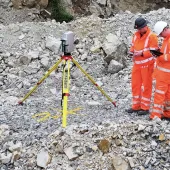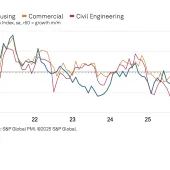Buoyant house-building sector sees mortar sales surge

House building boosts construction activity as shovel-ready infrastructure projects fail to materialize
SURGING mortar sales suggest that house building in Great Britain remained buoyant in 2018, with the latest data from the Mineral Products Association (MPA) recording volumes at their highest level since records began in 2004.
Year-on-year mortar volumes increased by 14.3%, despite tailing off in the fourth quarter with a 1% decline. The majority of mortar sales take place within six months of house-building projects starting, with increased volumes indicating that new starts were positive during 2018.
This trend suggests more cause for optimism than other market indicators such as Office for National Statistics (ONS) data on brick deliveries, where a lacklustre 1.6% increase in the 12 months to the third quarter of 2018 may be attributable to previous stockpiling and import volumes.
Beyond house building, the wider picture of construction demand for essential mineral products is more muted, reflecting an industry still waiting for major projects to break through Brexit uncertainty and become shovel ready.
Ready-mixed concrete sales volumes fell 1.6% nationally in 2018, weighed down by reduced demand in London, where sales declined by 4.8%. The ubiquitous material is a bellwether for general construction activity, with weak house building and commercial construction markets in the capital contributing to the drop in sales.
However, while significant projects such as the Thames Tideway Tunnel may sustain demand for ready-mixed concrete in the coming months, the timing of any uptick remains unclear.
Meanwhile, asphalt sales remained broadly flat in 2018 with major projects on the strategic network yet to come online. The MPA’s analysis shows that the southern regions of England and Wales led asphalt sales last year, contributing to a 0.7% growth nationally and offsetting declines in most other regions.
This modest growth is likely to reflect greater local authority activity, which may continue to grow in the first quarter of 2019 following the Chancellor’s Budget announcement of £420 million of additional funding to tackle potholes in the current financial year.
Many major projects slated for the strategic network as part of Highways England’s Roads Investment Strategy 1, have yet to make an impact on the ground as the programme is heavily backloaded to 2019, 2020 and 2021.
Aurelie Delannoy, director of economic affairs at the MPA, commented: ‘Like many sectors, construction is awaiting the outcome of Brexit negotiations, but our data show that Great Britain is still building despite the uncertainty.
‘In particular, strong mortar sales indicate continuing new house-building projects in 2018. Our analysis, based on actual sales and on-the-ground activity rather than sentiment, suggests this has been higher than forecasted by other metrics.
‘Elsewhere, the picture for the industry is more muted as we wait for several major infrastructure schemes to make the leap from the planning phase to the construction site.
‘Policymakers and clients need to be mindful that the critical mineral resources that underpin our built environment don’t flow from a tap, and preparations to ensure a ready supply need to begin early in a project’s life cycle.’








